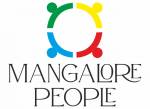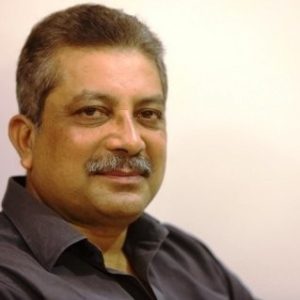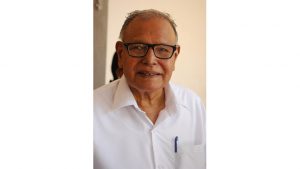
????????????????????????????????????????????????????????????
Kota Shivaram Karanth also known as K. Shivaram Karanth, was an Indian polymath, who was a novelist in Kannada language, playwright and an ecological conservationist. Ramachandra Guha called him the “Rabindranath Tagore of Modern India, who has been one of the finest novelists-activists since independence”. He was the third writer to be decorated with the Jnanpith Award for Kannada, the highest literary honor conferred in India. His son Ullas is an ecological conservationist.
Shivaram Karanth was born on 10 October 1902, in Kota near Kundapura in the Udupi district of Karnataka to a Kannada-speaking Smartha Bhramin family. The fifth child of his parents Shesha Karantha and Lakshmamma, he completed his primary education in Kundapura and Mangalore. Shivaram Karanth was influenced by Gandhi’s principles and took part in Indian Independence movement when he was in college. His participation in the Non-cooperation movement did not allow him to complete his college education which he quit in February 1922. He canvassed for khadi and swadeshi in Karnataka led by Indian National Congress leader Karnad Sadashiva Rao, for five years till 1927. By that time, Karanth had already started writing fiction novels and plays.
Karanth began writing in 1924 and soon published his first book, Rashtrageetha Sudhakara, a collection of poems. His first novel was Vichitrakoota. Subsequent works like Nirbhagya Janma (“Unfortunate Birth”) and Sooleya Samsara (“Family of a Prostitute”) mirrored the pathetic conditions of the poor. His magnum opus Devaddhootaru, a satire on contemporary India, was published in 1928.
Karanth was an intellectual and environmentalist who made notable contribution to the art and culture of Karnataka. He is considered one of the most influential novelists in the Kannada language. His novels Marali Mannige, Bettada Jeeva, Alida Mele, Mookajjiya Kanasugalu, Mai Managala Suliyalli, Ade OOru Ade Mara, Shaneeshwarana Neralinalli, Kudiyara Koosu, Svapnada Hole, Sarsammana Samadhi, and Chomana Dudi are widely read and have received critical acclaim. He wrote two books on Karnataka’s ancient stage dance-drama Yakshagana (1957 and 1975).
He was involved in experiments in the technique of printing for some years in the 1930s and 1940s and printed his own novels, but incurred financial losses. He was also a painter and was deeply concerned with the issue of nuclear energy and its impact on the environment. At the age of 90, he wrote a book on birds (published during 2002 by Manohara Grantha Mala, Dharwad).
He wrote, apart from his forty-seven novels, thirty-one plays, four short story collections, six books of essays and sketches, thirteen books on art, two volumes of poems, nine encyclopedias, and over one hundred articles on various issues. His Mookajjiya Kanasugalu novel won Jnanpith award.
Karanth began writing in 1924 and soon published his first book, Rashtrageetha Sudhakara, a collection of poems. His first novel was Vichitrakoota. Subsequent works like Nirbhagya Janma (“Unfortunate Birth”) and Sooleya Samsara (“Family of a Prostitute”) mirrored the pathetic conditions of the poor. His magnum opus Devaddhootaru, a satire on contemporary India, was published in 1928.
Karanth was an intellectual and environmentalist who made notable contribution to the art and culture of Karnataka. He is considered one of the most influential novelists in the Kannada language. His novels Marali Mannige, Bettada Jeeva, Alida Mele, Mookajjiya Kanasugalu, Mai Managala Suliyalli, Ade OOru Ade Mara, Shaneeshwarana Neralinalli, Kudiyara Koosu, Svapnada Hole, Sarsammana Samadhi, and Chomana Dudi are widely read and have received critical acclaim. He wrote two books on Karnataka’s ancient stage dance-drama Yakshagana (1957 and 1975).
He was involved in experiments in the technique of printing for some years in the 1930s and 1940s and printed his own novels, but incurred financial losses. He was also a painter and was deeply concerned with the issue of nuclear energy and its impact on the environment. At the age of 90, he wrote a book on birds (published during 2002 by Manohara Grantha Mala, Dharwad).
He wrote, apart from his forty-seven novels, thirty-one plays, four short story collections, six books of essays and sketches, thirteen books on art, two volumes of poems, nine encyclopedias, and over one hundred articles on various issues. His Mookajjiya Kanasugalu novel won Jnanpith award.
Karanth married Leela Alva, a student in the school that Karanth taught dance and directed plays in. Leela belonged to the Bunt community and was the daughter of a businessman, K. D. Alva. They married on 6 May 1936. The couple subsequently attracted ridicule from people in the region over their inter-caste marriage; Karanth belonged to an orthodox Brahmin community. Leela, who had her early education in Marathi language, re-learnt Kannada after marriage and translated the Marathi novel Pan Lakshat Kon Gheto into Kannada. As a dancer, she participated in Karanth’s operas. The Karanths had four children together: sons, Harsha and Ullas, a conservationist; and daughters, Malavika and Kshama. His mother’s influence on Karanth was described by Ullas as: “It was our mother who shaped Karanth’s life… She was the backbone of all his endeavours. She was also quite well-read, and she dedicated all of her talents to her husband. She took care of all household responsibilities.” The family lived in the Puttur town of Dakshina Kannada, a district in the South Karnataka region, before moving to Saligrama, a town 2 miles (3.2 km) from Karanth’s birthplace Kota, in 1974.



